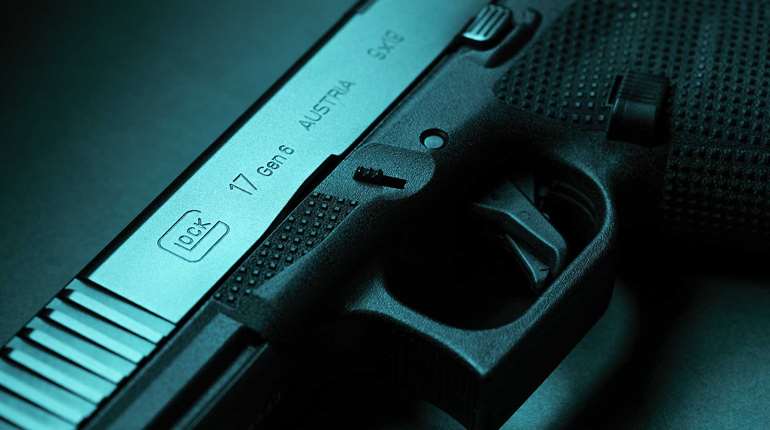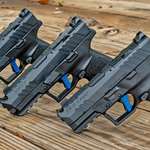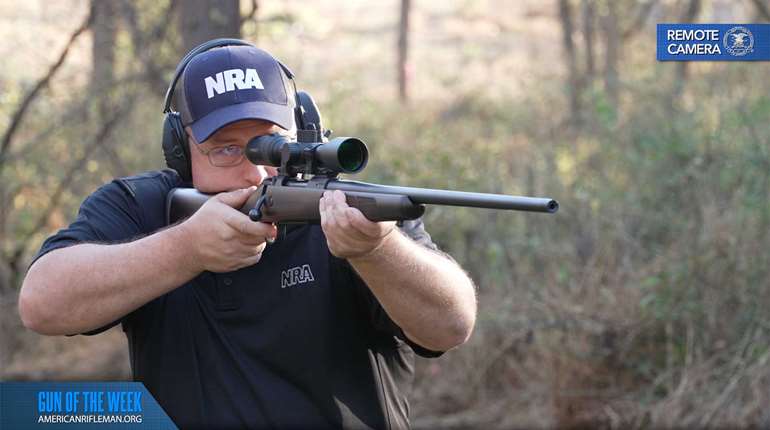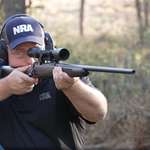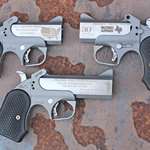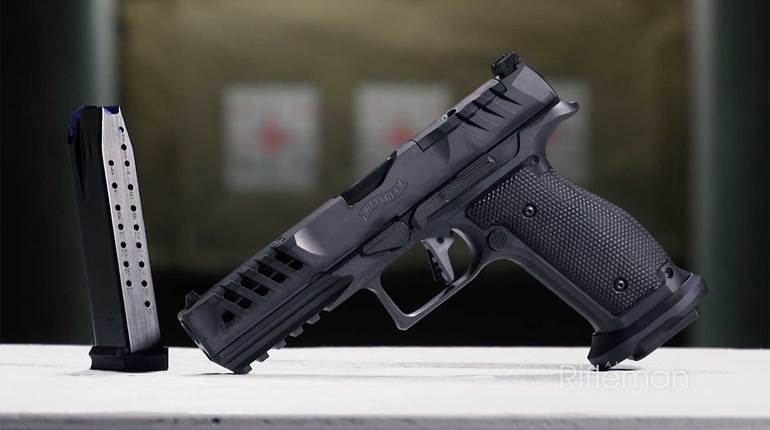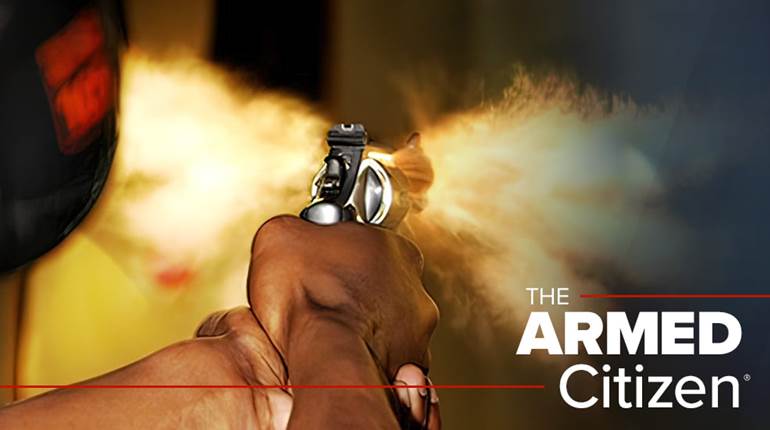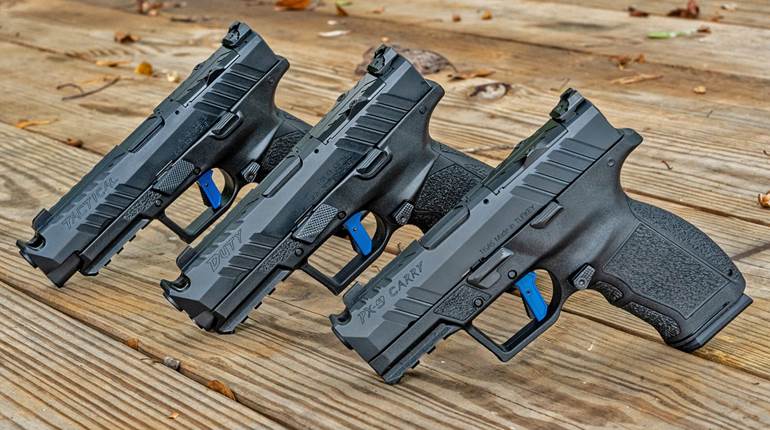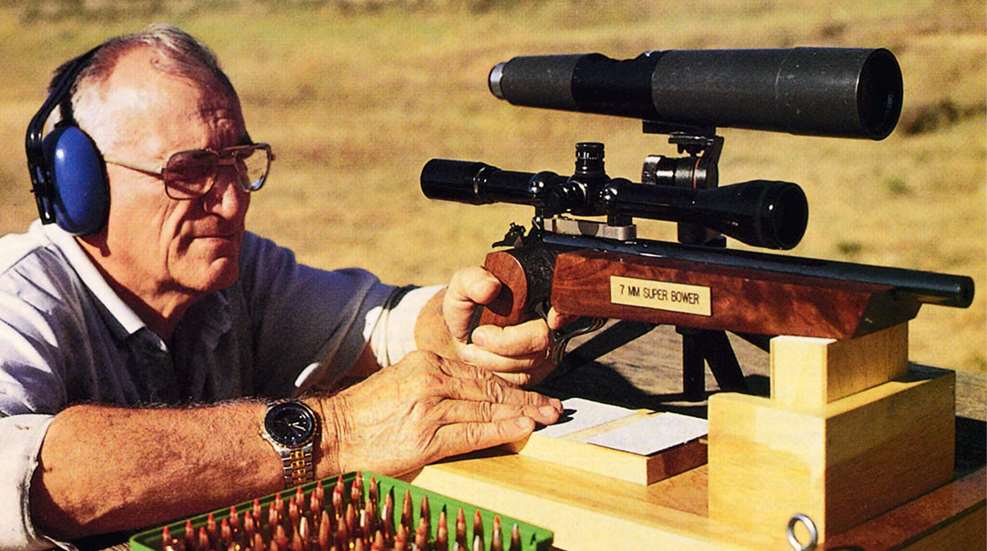
This article, "Ultimate Pistol Accuracy: 1.5" Groups At 1/4 Mile," originally appeared in the June 1995 issue of American Rifleman. To subscribe to the monthly magazine, visit NRA’s membership page.
The odyssey that brings Don Bower's story to these pages from Colorado began with his letter to NRA back in 1993. Because it was critical of the magazine, it landed on my desk at the American Rifleman.
"Since 1981," Bower began his letter, "I have been successfully rechambering existing T/C Contender 14" barrels to unprecedented achievements. I shoot consistent 1.5" center to center 3-shot groups all day long at 500 meters with .22, 6 mm, .25 cal., 6.5 mm, 7 mm and .30 cal. Yet after years of trying to get the news out I have been shunned." Bower had more to say, a lot more.
"This is impossible," I said to myself and anyone around our offices willing to listen and knowledgeable enough to know this kind of accuracy was improbable. But the letter required a response, and I plotted my strategy. First, I called George Nyfeler, then the NRA field representative for Colorado. "Would you mind checking this out?" I asked Nyfeler. "Sure," he said. I basked in the glow of my own canniness.
In little more than a week, Nyfeler's lengthy fax spilled out of our machine. "I opened my mind as much as I could in the face of such a claim," Nyfeler wrote me. "In a word, which 1 will detail below," he continued, "the man is for real. He and his friends consistently shoot 0.4-0.6 minute of angle groups at 500 meters from 14" Thompson/Center Contenders with multiple calibers, and with hunting bullets."
Trapped. Now I had to find a way to do the story. Nyfeler promptly steered me to an experienced shooter and writer, John Eaton. This is my apology to Don Bower. —Ron Keysor, former managing editor, American Rifleman
Don Bower is a man who has completed a mission: he has discovered the secrets of shooting a handgun— with consistent, mind-boggling accuracy—at 500-meter targets and printing groups that can be covered with a baseball or, often, a golf ball.
Consider how that kind of accuracy could cause heart palpitations in a prairie dog colony—or boost your ego.
Bower knows he can do it. His brother, John, also a crack shot, knows he can do it. A handful of witnesses over the past few years have observed Bower and others at work and have seen it done.
And Bower wants to share his discovery with the shooting fraternity, but there are strange obstacles.
Shooters are an odd—nay, stubborn—group, and often seeing isn't believing. Handguns simply aren't capable of tight groups at 500 meters (547 yards), or so they say. That's it. It can't be done.

Some have seen it done, then turned on their heels, pronounced it impossible and left the range, convinced they didn't see what they had witnessed, joining that special group of hidebound traditionalists who are a little cocked and unlocked.
But if you have an open mind, read on and discover how Bower goes about sending bullets, .22 to .30 cal., downrange to snuggle together with near monotonous regularity.
During the past 12 years Bower, his brother, and a small group of Denver-area long-range shooters have been meeting regularly to pit pistols, wits (often ribald) and wind-estimating talents, and they frequently carry home targets with two- or three-shot groups that hover around 3".
This is a story of one man's love affair with handguns and his staunch belief that the new breed of single-shots is capable of accuracy at faraway targets heretofore unknown. It is also a story of hope to anyone interested in experimenting with firearms.
Bower's guns and accessories are disarmingly simple and don't require a homestead-threatening outlay. And his secret, if it is a secret, can be applied by anyone willing to adapt to new, controversial reloading techniques. He works with Super 14 Contenders, Burris 10X IER scopes, Burris mounts, his own customized stocks and forearms, and usually with Nosier bullets, in seven Bower wildcat cartridges (all rimmed, ranging from a varmint-finding .22 to a stump-removing .358).
The recipe is seasoned with more than four decades of acquired shooting discipline that began with Air Force shooting team competition. But now that his eyes and iron sights are incompatible—he's well into his 60s—Bower, like many mature shooters, has discovered he can extend his productive, precision shooting life by nailing targets using optics.
After earning a gunnysack of competitive rifle and pistol shooting awards during his military years, Bower decided after retiring from the Air Force in 1971 that in order to continue to enjoy shooting, he would have to go to scope sights. "I could see the iron front sights, but there were too many of them," he says.
He tried rifle silhouette competition, but found it too repetitive. But at the same time T/C Contenders were earning praise for reliability and accuracy at 200 meters. Bower, always curious and always an experimenter, says he was attracted to their design, strength, simplicity and inexpensive barrel interchangeability. He was convinced they had untapped capabilities, but not with the cartridge selection then available. Though Bower suspected the proper cartridge for the Contender hadn't been designed, small groups at 500 meters hadn't entered his mind.
His first wildcat was the .358 Super Bower, fashioned from a .35 Rem. T/C barrel. A one-shot elk kill at very long range convinced him he had something, but he had headspace trouble because of the rimless case design. This was before the advent of the .307 Win. rimmed case in 1983, so he used the rimmed .444 Marlin case and ran it into an altered .35 Whelen die.
He uses extended case necks on all the wildcats he designed that allow all bullet weights to be seated into the rifling origins. "This big case with the sturdy rim solved the headspace problems with the rimless case," he says.
Case separation problems were eliminated by moving the shoulder back .002", which Bower says allows the case to expand forward instead of rearward into the web area when fire-formed. The .358 cartridge was essentially a .358/.444 Marlin.
That load was a 200-gr. RCBS gas-check cast bullet ahead of Hodgdon H322. Bower is a fan of the Powley computer (a sliderule- like powder charge/velocity calculator created by ballistician Homer Powley) and has used it for 15 years. He computes that load at 2,316 f.p.s. with a whopping 2,382 ft.-lbs. of energy at 41,000 p.s.i. Original cases lasted for three years of frequent firing. Another load was a 200-gr. Hornady Spire Point using H322 with a Powley-computed 2,260 f.p.s. and 2,268 ft.-lbs. of energy at 42,200 p.s.i.

Bower had set top accuracy at 500-meter targets as his goal for a simple reason: that was the longest distance available to him at his nearest range east of Denver. In spite of having a wildcat that shot accurately and developed safe pressures of 44,500 p.s.i., he says groups smaller than pie-plate size were unattainable with the low-power pistol scopes then available in the late 1970s.
Then, like the cavalry charging to the rescue, enter the Burris Co. of Greeley, Colorado. It was the early 1980s, and the company produced the first high-powered pistol scopes with strong internal design to resist heavy recoil—first the 7X IER in 1983 and then the 10X IER in 1984. Burris took an interest in Bower's experiments and supplied him with the new scopes as they were developed by the company. Bower says group size immediately went from pie-plate to tennis-ball-size—or smaller—at 500 meters. "The accuracy was there all the time, but we couldn't capitalize on it with those low-power scopes," he remembered.
A word here on how Bower and that small group of long-range handgun aficionados shoot—and most of all see— groups at 500 meters. Naturally, quality spotting scopes manned by spotters are used, but the job of spotting groups at such distances has been made much easier by shooting at heavy metal plates suspended from target holders.
Before a group is shot, the dark metal plate is sprayed with white paint. Each bullet then makes a dark splatter mark easily seen through a spotting scope and, later, the exact point of bullet impact is easily noted for precise measurement. After the optics problem was solved, Bower started to hone his wildcats and bench shooting techniques to shrink group sizes by even more.
He has a rule of never violating a self-imposed limit of 44,500 p.s.i. His fired cartridges literally fall out of the chamber and case life seems endless. Standard T/C 14" barrels are used and rechambered to Bower's specifications. In .30 cal., he prefers the older barrels with six grooves and 1:14" twist.
Bower has designed many wildcats, but he has settled on six favorites. formed from .307 Win., .356 Win. or .444 Marlin brass: the .22, 6 mm, 6.5 mm, 7 mm and .358 Super Bowers and the 30 (no decimal) Alaskan Bower.
His design theory follows certain dictates: backthrust in the Contender action is minimized by using a 40° shoulder. Loading density is usually maintained at about 90% by careful propellant selection, and he believes this leads to better accuracy.
The slow-burning powders chosen after extensive experimentation have proven to burn completely, leave little residue and exhibit minimal muzzle flash. Recoil for those accustomed to shooting center-fire handguns is surprisingly mild.

Most loads use Nosier Ballistic Tips, Sierra Spitzer boattails or Hornady Spire Points. Bower always seats 0.002" into the lands—after working up the load carefully— for two reasons. When the proper, safe and accurate load for a specific cartridge and handgun is devised, the pressures remain constant, and the bullet in that rimmed case is concentric with the barrel.
A discussion of cartridges and loads is fine, but much of the talent of getting small bullets in small groups at long yardage lies with the shooter. Any error at the firing line must be kept to an absolute minimum.
As an aid in achieving horizontal and vertical stability, Bower alters the T/C stocks and replaces the fore-end. He rests the gun on an adjustable commercial bench rest or a simple wooden rest of his own design. A wide, flat base is attached to the butt of the stock and the fore-end is also wide and flat to eliminate cant. In addition, the latter part has a slight front-to-rear downward curve. The shooter can set the gun on the rest and slide it forward or backward— minimally—and achieve a degree of elevation adjustment. It takes only a fraction of an inch to get noticeable vertical change at 500 to 1,000 meters.
In addition, the fore-end rests on a metal forward rest that is threaded and adjustable for height or a homemade wooden rest that is vertically adjustable by moving the forward base up or down in a series of slots.
Another key to steadiness is the use of adhesive-backed sandpaper applied to the rest where the grip and fore-end rest. Try those techniques. There is no lateral or fore/aft movement. Next, you orient the sights on the target and press the trigger— and for most shooters this is where Bowers says they make a basic error and all the careful preparation goes down the disposal.
Bower can take a neophyte handgunner (but, one who is, basically, a good, disciplined shooter), hand him one of his tack drivers, coach him on bench techniques and how to check for scope parallax (an absolute must), and watch him place two or three shots in a small group at 500 meters.
And then the shooter blows it with a wild shot. Ever hear a retired sergeant growl and bellow? It sounds like a bear with a boil.
This is the point where Bower gives one of the most important—simple and possibly most difficult to learn—lessons on longrange shooting: Center the sights on the target and then look at the crosshairs or dot, not the target! And press the trigger slowly.
He believes many shooters, when firing at 500 meters, have a hard-to-suppress tendency to look at the target, then the reticle, and then let their vision float back to the target. Back and forth. This causes the reticle to wander about, stimulated by subconscious hand movements. This is a sure-lire way for beginners to get flyers, and they will often walk away saying it can't be done.
Here are Bower's "secrets" in a nutshell; write them on the back of your hand.
- Choose a stiff 14" barrel that gives minimal whip.
- Choose a well-balanced rimmed cartridge like one of Bower's wildcats (the 7x30 Waters has served well for this kind of shooting). Accuracy combined with safe loads is the key, not raw power.
- Seat bullets 0.002" into the lands.
- Make sure you have a perfect barrel crown.
- Fashion properly shaped stocks and use a good rest and sturdy bench.
- Use spray-painted metal targets to simplify spotting shots. You soon will be straitjacketed and towed away if you try to spot bullet holes in paper at 500-1,000 meters.
- Look at the reticle, not the target, when releasing the trigger.
- And press that trigger slowly. Better yet, kiss it.
- Do it. Be a believer.
By the way, the smallest group shot by those persistent Colorado long-rangers when this report was prepared was a 5/8" by 3/4" three-shot cluster. A quarter covers the group. Even his mother didn't believe it. It's lonely out there.
How Bower Crafts His Wildcats
Here is how Don Bower forms his wildcat cartridges and his favorite loads sans charge weights:
.22 Super Bower—based on .307 Win. rimmed case, formed with four passes in a four-die set, followed by fire forming. It reaches 3,313 f.p.s. with a 50-gr. Nosier Ballistic Tip in front of an H380 charge.
6 mm Super Bower—.307 case and three passes in a three-die set, followed by fireforming to reach 3,000 f.p.s. with 70-gr. Sierra Match bullet using Reloder 19.
6.5 mm Super Bower— .307 Win. case and one pass in a 7 mm/08 die and one in a 6.5 Super Bower die and then fire-forming to reach 2,920 f.p.s. with an 85-gr. Sierra hollow point flat base bullet with H450.
7 mm Super Bower—.307 Win. case and one pass in a 7 mm Super Bower die to hit 2,474 f.p.s. with a 140-gr. Sierra SPBT pushed by H450. Note: Bower frequently employs 1-1450 because it gives good case capacity combined with low pressures.
30 Alaskan Bower—.307 Win. case and load and fire-form. A favorite load is a 165-gr. Nosier Ballistic Tip with a compressed charge of H450 (this is his only compressed charge).
.358 Super Bower—.444 Marlin case and one pass in the .358 Super Bower die. Then trim case length to 2.015" and load and shoot. Use the 180-gr. Homady Spire Point with an Accurate Arms 2230 charge.
Bower recommends that new shooters begin by reducing charges by 10% with his suggested loads and working up, watching for pressure signs. They have proven mild in Bower's experience in rechambered T/C 14" barrels. His loading data was all developed at about 5,000 ft. above sea level in temperatures averaging about 65° F. —John Eaton
"Donald Ross Bower, 84, passed away Tuesday October 15th, 2013. He was born to the late Ross and Kathleen Bower on Jun 12th, 1929, in Beverly, MA. He married the late Joan Shaw Bower on Jan. 14th, 1956, and lived all over the U.S. until they settled in Aurora, CO in 1968."
















